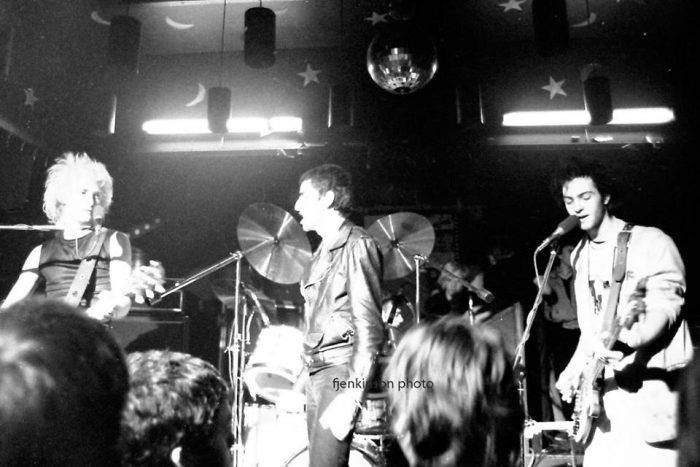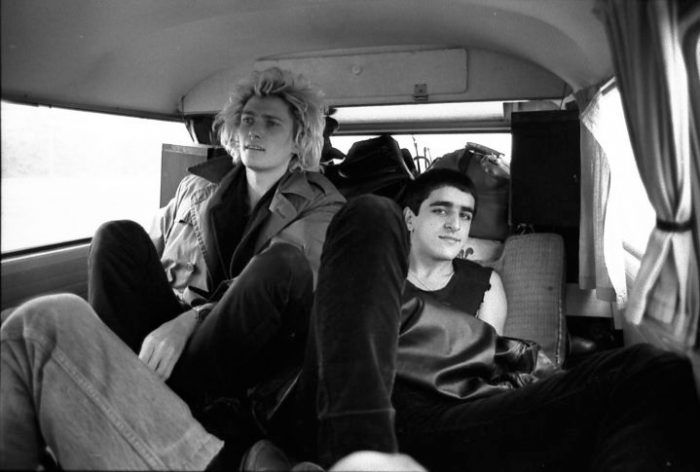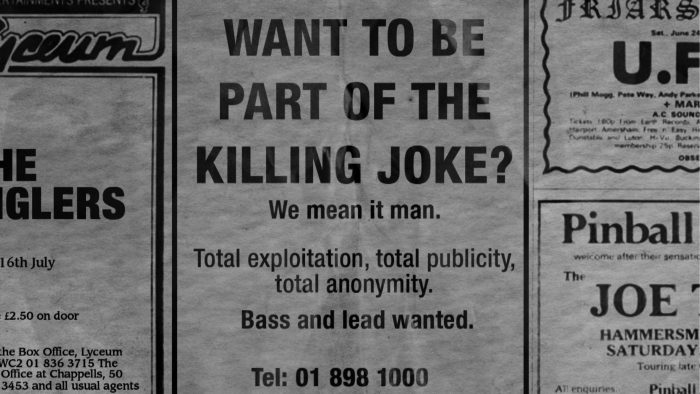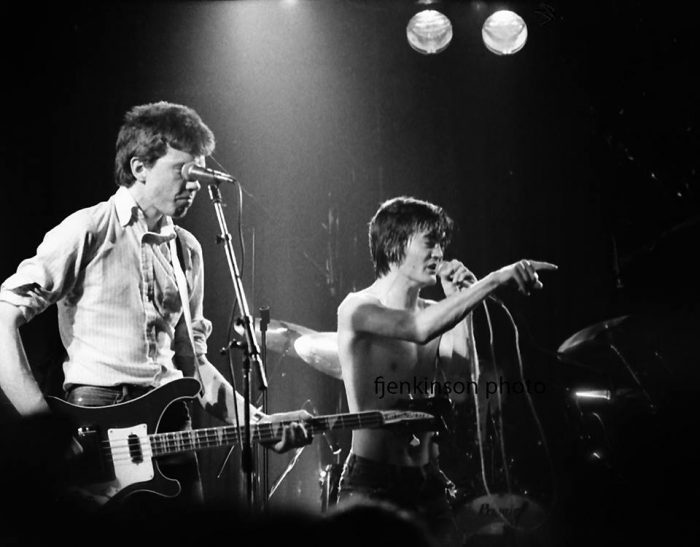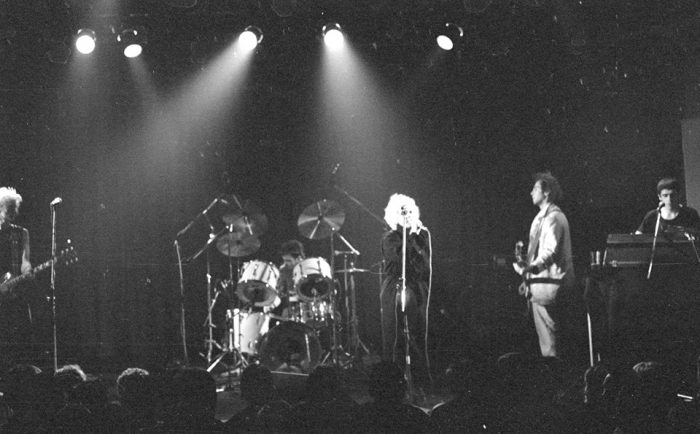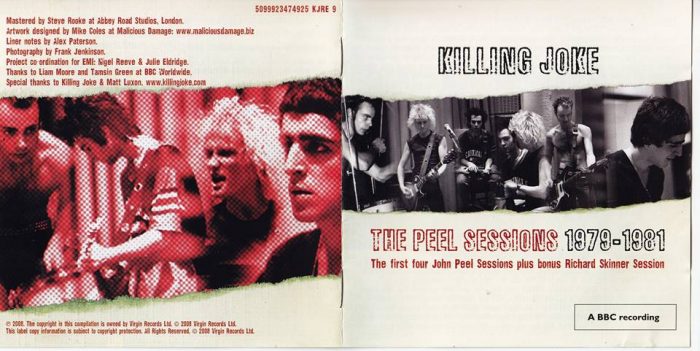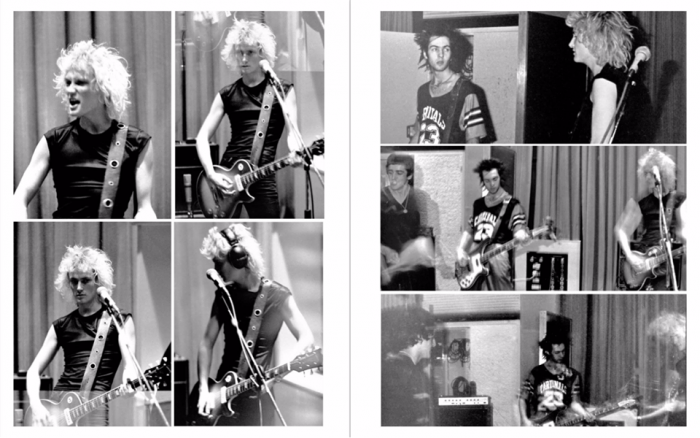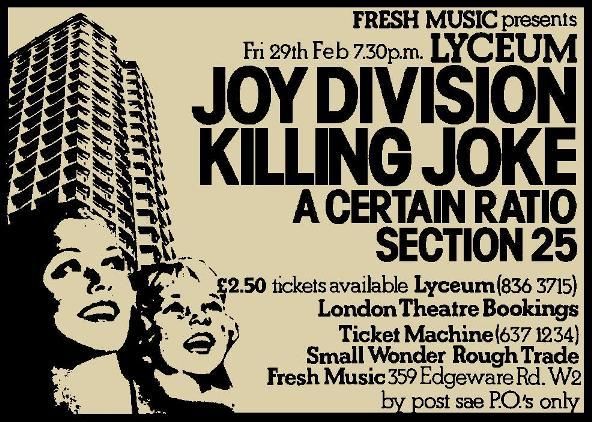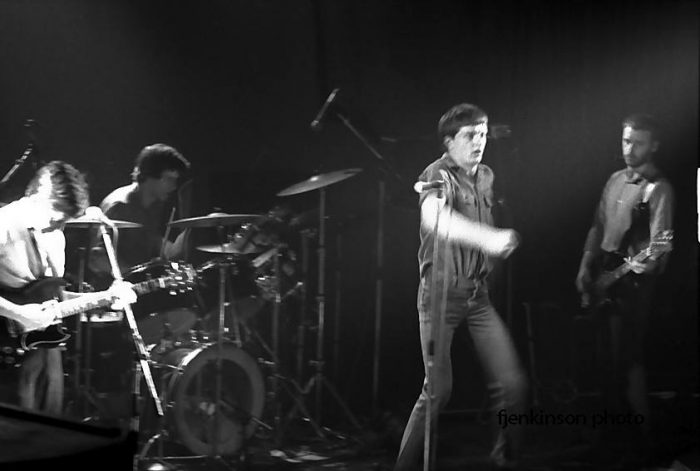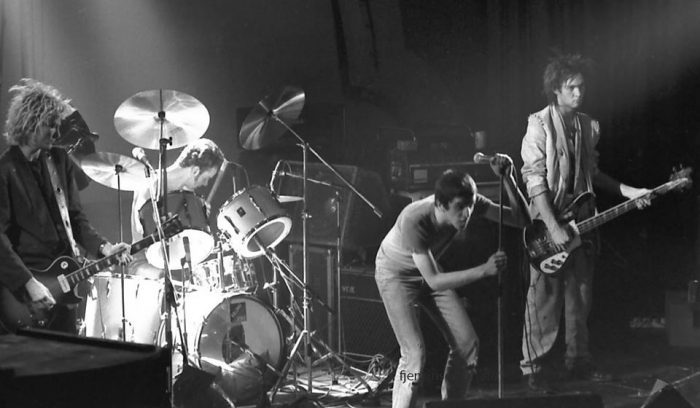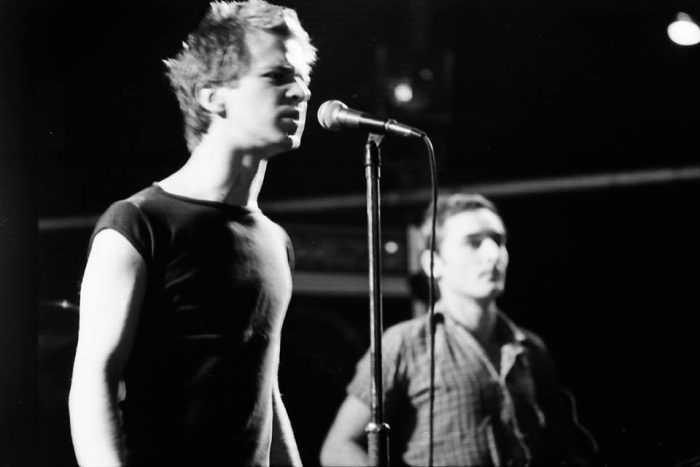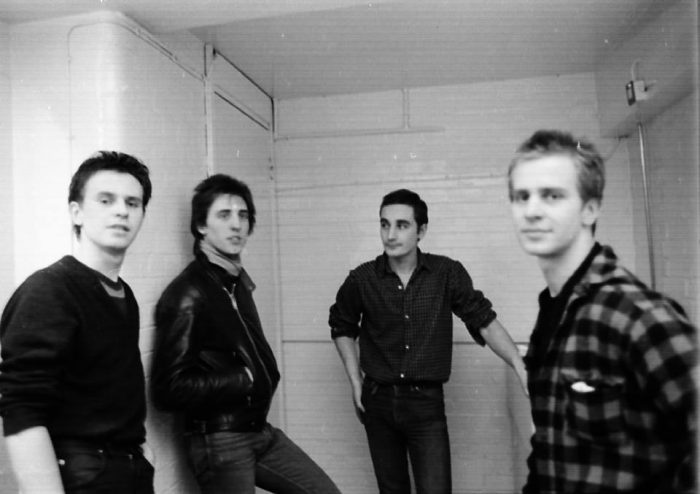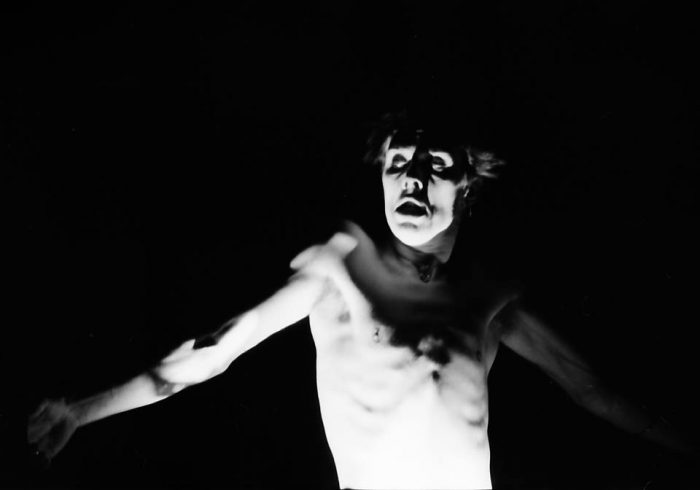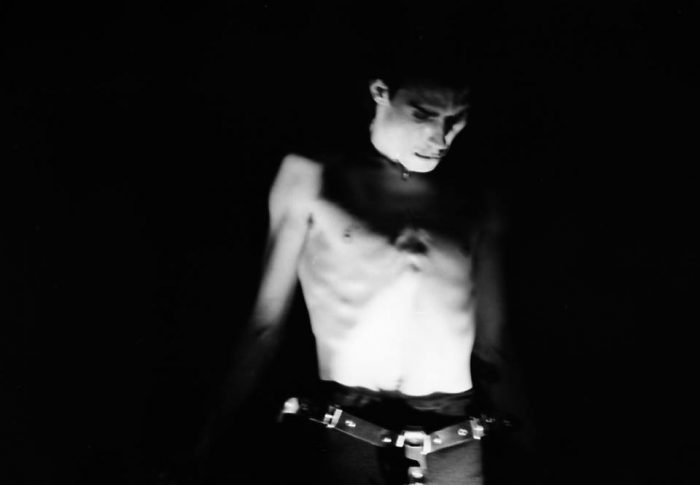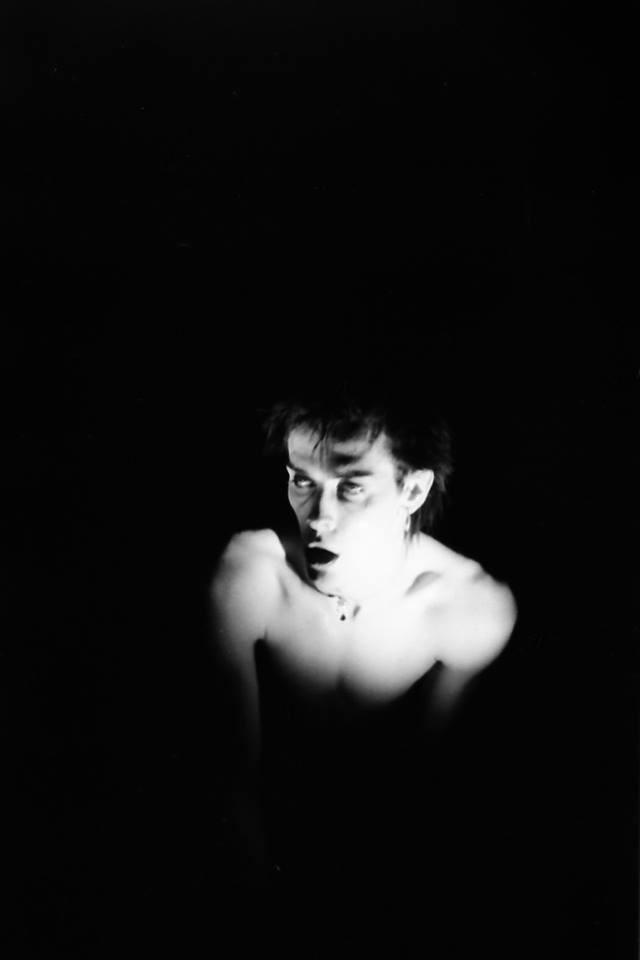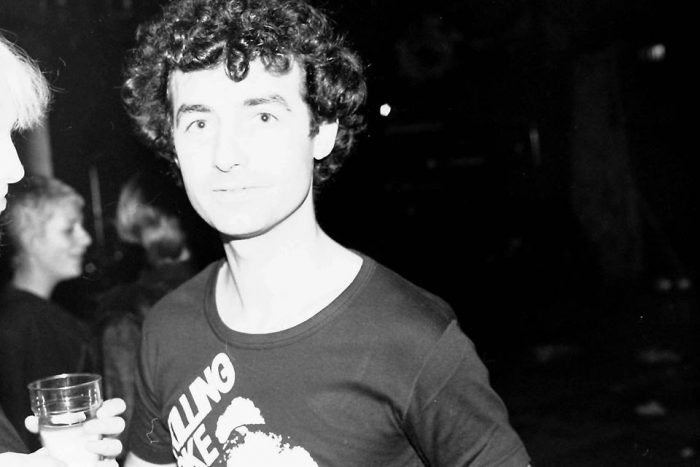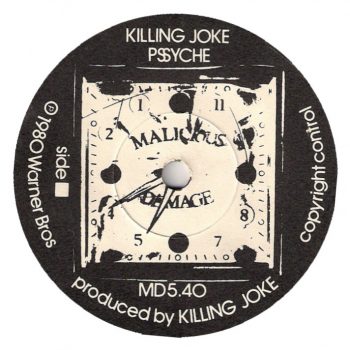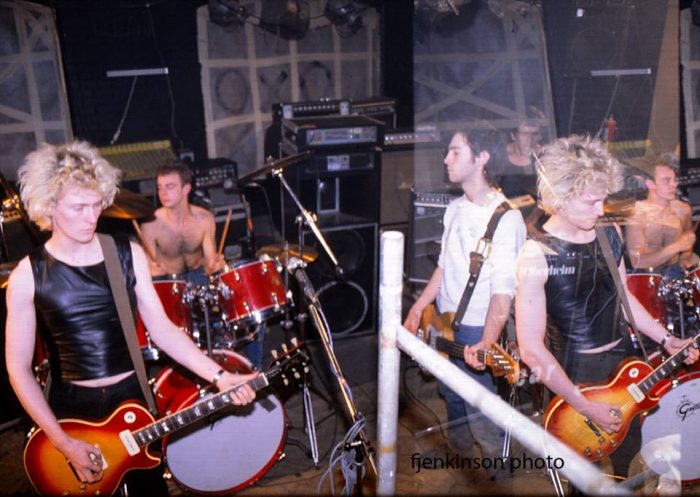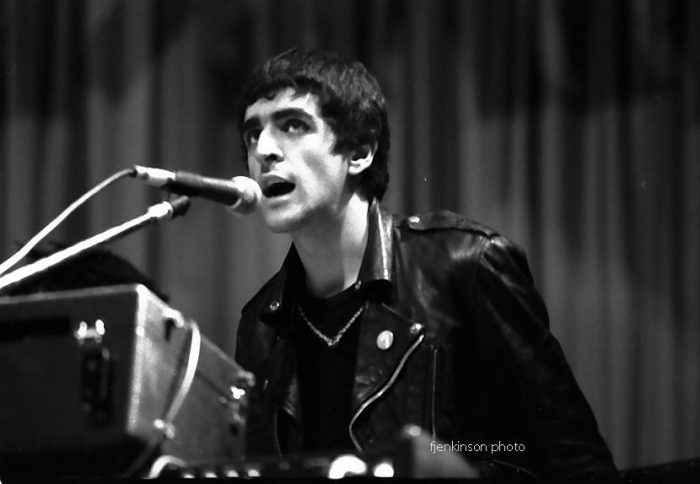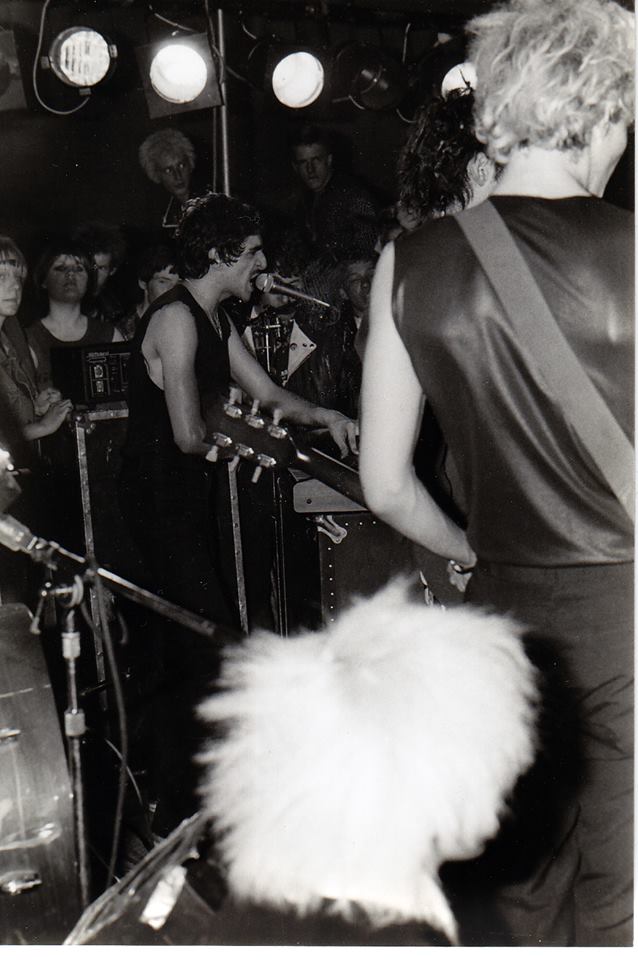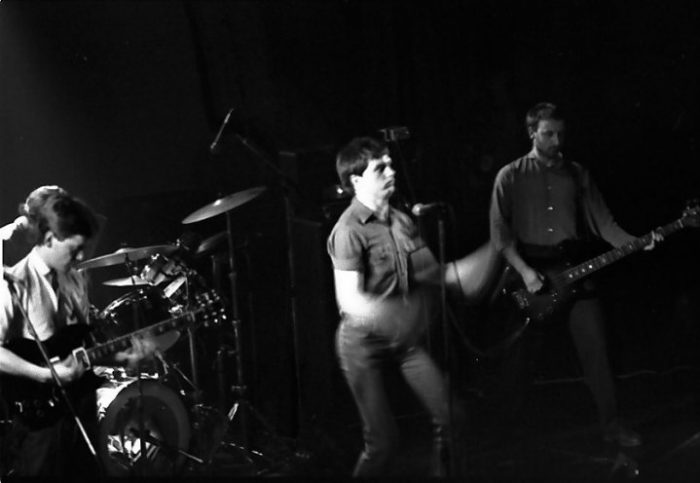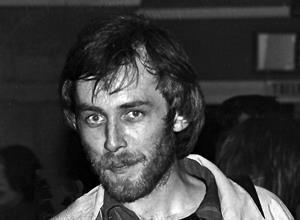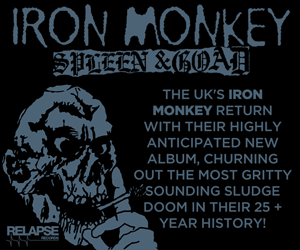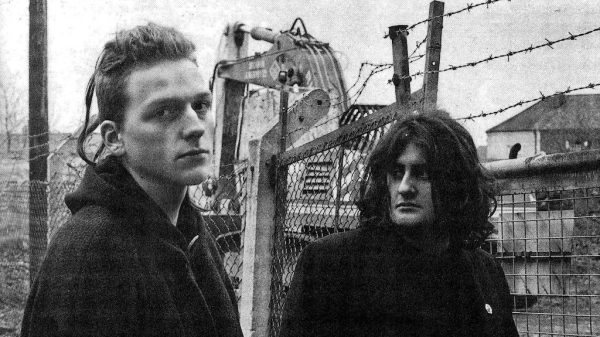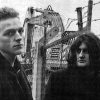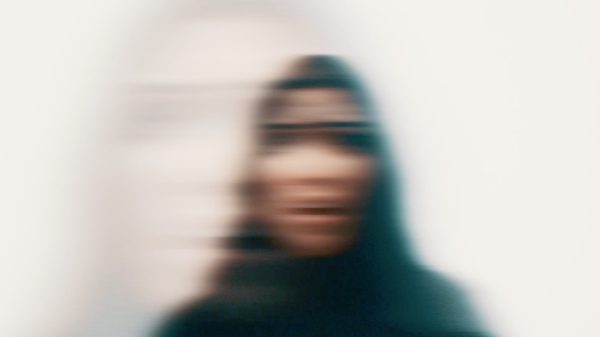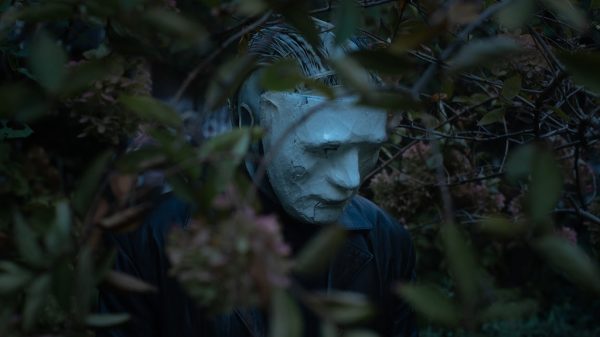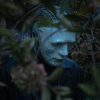Frank Jenkinson started taking photos of Killing Joke before the band had even formed. In 1978, he was flatmates with the girlfriend of drummer Big Paul Ferguson and had started taking snapshots of a band that Paul was in with local keyboardist Jeremy “Jaz” Coleman — the Matt Stagger Band. Dissatisfied with the Matt Stagger Band’s musical direction, Paul and Jaz left to create a new outlet for their vision of a musical apocalypse; the volatile new group was christened Killing Joke.
In the meantime, another of Frank’s housemates, Brian Taylor, decided to start a label with some others to manage the new band. That label was called Malicious Damage, and within the space of about 10 months it succeeded in pressing Killing Joke’s first EP (“Turn to Red”), got it into the hands of John Peel, and procured the band’s first Peel Session (October 1979). Frank Jenkinson found himself in the right place at the right time, so he started taking pictures.
Frank stayed alongside the new band and label until Summer 1981, documenting Killing Joke’s early days and getting photos of many of the postpunk acts that were around at the time: Bauhaus, Joy Division, the Undertones, Cabaret Voltaire, Ski Patrol, and more. Recently, Frank published a book of his photos of Killing Joke’s first full year of existence, Killing Joke Picture Book 1979 (available from Blurb UK).

Peter Murphy of Bauhaus in 1980, by Frank Jenkinson.
I decided to pick Frank’s brain about his experiences documenting Killing Joke and the surrounding London postpunk scene. Below, he shared his stories about what it was like to be around the energy of the bands in that moment and what drove him to photograph it all.
Frank Jenkinson was interviewed by Oliver in April, 2017.
Frank, you seem almost like the official Killing Joke photographer and visual archivist for their early era, the late 1970s until about 1981 or so. Can you explain how this role came about?
Frank Jenkinson: The story revolves around 11 Portland Rd, London w11, a couple blocks from Ladbroke Grove and Portobello Road. I arrived in London about 1976 and moved around before settling into No. 11 in 1978. I found the address through a friend, Philip R., who lived there. Over time, the house got populated. Brian Taylor was there, and so was Christine Atkinson, who was (Killing Joke drummer) Big Paul’s girlfriend at the time.

The origins of Killing Joke: Jaz Coleman with the Matt Stagger Band in 1978. Photo by Frank Jenkinson.
FJ: Philip met Jaz Coleman and brought him over to the house one day. In some ways it was serendipity; random meetings between people at the house evolved into something bigger. Geordie (guitarist) and Youth (bass) were found along the way.
As Killing Joke got started, Brian Taylor formed the Malicious Damage record label, which released the early Killing Joke material. Adam Morris, (artist) Mike Coles, Dick Laban, and Danny Phelan were also on board. The idea was they would all put some money into the label and manage Killing Joke and record their records. I was not part of Malicious Damage, but I had the camera and could document stuff for free. The problem was that Killing Joke were difficult to photograph. “Total Anonymity” was their initial motto. They would never cooperate – not with me, anyway. Only one time did they actually pose for a shoot, in what I call the “No Petrol” photos (see petrol station photo above).
FJ: So most of the Killing Joke photographs were of gigs. I was just there – almost invisible, I think, but that suited me. In the Autumn of 1979, the band was getting it together. At that time, John Peel picked them up and started playing them and wanted them to come in and do a radio session. Killing Joke were so good that he thought they were The Stranglers under a fake name!
After the Peel Sessions, events moved on. I went to the London gigs mainly. Film was expensive, but I bought it wholesale and rolled the film under the bed clothes into cassettes, as much as I could get in. I rarely used flash, and pushed the ASA speed to the limits of its sensitivity. This produced some grainy shots but also became a dynamic style. I would hire dark rooms at Battersea Arts Centre for days at a time. In that time I only sold two photographs and got paid for one, by ITV, which paid for a long lens. The idea was to take lots of photographs and animate them. Video was in its infancy and most recorders were still reel-to-reel. VCR cassettes were unavailable or very expensive. As Killing Joke gathered pace, the photography continued in the London area with, for me, rare journeys outside, depending on my work commitments, to 1981. By that time, a couple of things happened: the house at No. 11 was sold. We were all dispersed. Malicious Damage was having issues with distribution and other issues so all that had to be sorted, and more major labels were interested in Killing Joke. There is a comprehensive account of this time available at the Kill Your Pet Puppy page: http://killyourpetpuppy.co.uk/news/killing-joke-malicious-damage-records-1979-2/
As it goes, however, despite their reluctance to be photographed, Killing Joke must be one of the most unknowingly comprehensively documented bands of that time.
Were you a witness to the Ladbroke Grove postpunk scene? What are some of the memories you have then? Some of the standout bands and events?
FJ: Initially, I was living in Wimbledon, which is outside central London. I missed out on the first wave of stuff. Blondie was the nearest I came to seeing that scene. It was mixed scenes that were mainly around, mixed with pub rock, with a few groups being of interest, like The Cure. And, as it happens, on the US side the Talking Heads made me perk up, and then the Undertones caught my attention when I moved to No. 11. Life just went on and all seemed normal when… I remember when The Police had “Roxanne” as a hit. Everybody was pissed off! They were local and making it big. Big Paul’s girlfriend, Christine, was friends with or knew Chrissie Hynde from the Pretenders. Annie Lennox was from Harrow Rd nearby…. I met the Dead Kennedys and Lemmy once; Killing Joke used Ear Rehearsal Room, the same rehearsal space and storage HQ that Motörhead used. The associations were fun – being famous by association was good, but not to be invested in. Other bands, like U2 – I went with some friends over from Ireland to see them, but did not take my camera. Joy Division, Thompson Twins in an early incarnation, and the Teardrop Explodes. Killing Joke, however, were genuinely the best thing around that time in my mind. But they were often self-sabotaging, though they would say that was all part of the plan.
You have some great photos of Killing Joke recording their Peel Sessions, and I think I’ve seen some of these used on official releases. What were the Peel Sessions like, and how long did they take? How was John Peel?
FJ: The Peel Session photos have appeared on the CD cover of the session gigs. Mike Coles was and is the graphic brains behind the Killing Joke image. He had various uses of my photos from time to time. The story about John Peel I’ve mentioned above, but getting to the point of the first Peel Session consisted of a lot of waiting outside the BBC and shoving the “Turn to Red” 10″ at the staff in question as they went in. When John Peel finally played the EP the reaction was amazing. It was sooo good, and then the first of the radio sessions was arranged.
FJ: That night of the Peel Sessions was a long one. Contrary to popular belief, John Peel himself was not around for them; he had left the engineers and producers to make the recordings. The band were full of themselves, they had arrived, the energy was great. Fuckin’ rock stars! The engineers had seen it all before and were pissed that it was going to be all night, and it was. Three tracks were laid, I remember, but another was needed. I have a “hoo hoo!” and clapping part on “Malicious Boogie,” the fourth/filler track. Suddenly it’s 6 AM. The John Peel session photos are in my book and recently I posted the photos of clocks from the studio session on Facebook to show how long the session took. I was only at Killing Joke’s first Peel Session and later the Capital Radio sessions.
What was life like then in that part of England? Economically, politically? In some of the photos you mention that Youth and Big Paul are wearing charity shop clothes – was all of the band poor? Did poverty influence the band in any way?
FJ: Yes, there was little money around. There was no credit, credit cards, bank cards, or anything like that, so you only spent what you actually had on you. You thought twice about spending money anywhere – just going drinking was a special event. Clothes were from jumble sales, thrift shops and so on, but punk encouraged that fashion. There was money for some things, though. Public assistance benefits were probably relatively more generous then than now, but I was always working. The band were on the usual £30 a week, and squatting was easy. The Tories were in power and inflation was kicking in.
Can you tell readers about the Joy Division / Killing Joke show you photographed at the Lyceum in February, 1980? What was that night like, and how did the members of Joy Division and Killing Joke seem to get along? Who had the better show that night?
FJ: Who had the better show but Killing Joke, of course? Joy Division at that time were not yet quite famous, but subsequent gigs were sold out very quickly. I failed to get entry on a few occasions following that show. Then Ian Curtis died a few months later…. That was unbelievable. Odd that Joy Division and Killing Joke both had very strong iconography. At the Lyceum show (it was a Victorian theatre with boxes going up the sides) I had managed to get into some of the boxes and took most of the photos from that elevated position. You could get away with doing things like that then. It’s all so controlled now. I’ll have to re-look at those photos again to jog my memory. They’re supposed to be in the second book I’m doing. I’ve not looked at them for awhile.
How were you able to pursue your photography interests in that time? Was the equipment you used very expensive or hard to get hold of?
FJ: I had a Canon AE 1, which I bought in New York for about half the cost of buying it in the UK. One summer I queued for two days for the emerging cheap flight tickets, bought a 6-week Amtrak ticket, did New York, Washington, Houston, the Grand Canyon, Los Angeles, San Francisco (where there was a small earthquake), Chicago (6 hours), and Detroit, where cousins of mine lived. Then I went back to New York. (Stayed in a hotel once.)
I was taking photographs anyway and doing other stuff than gigs. Film was expensive, but I bought it wholesale and like I mentioned above I rolled the film under the bed clothes into cassettes, as much as I could get in, so I did not have to over-worry regarding changing rolls. If a gig was good then often two rolls were used and finished, otherwise just maybe one, so a lot of photographs were taken. I rarely used flash unless I had to, but like I said I pushed the ASA speed to the limits of its sensitivity. Hiring the dark rooms at the Battersea Arts Centre for days at a time was relatively cheap; I remember going up there, carrying bottles of chemicals around on my bicycle. I only sold a couple of prints at that time. Most were black and white, which was easy to process. Later came the colour photos. I ruined a fair amount of film.
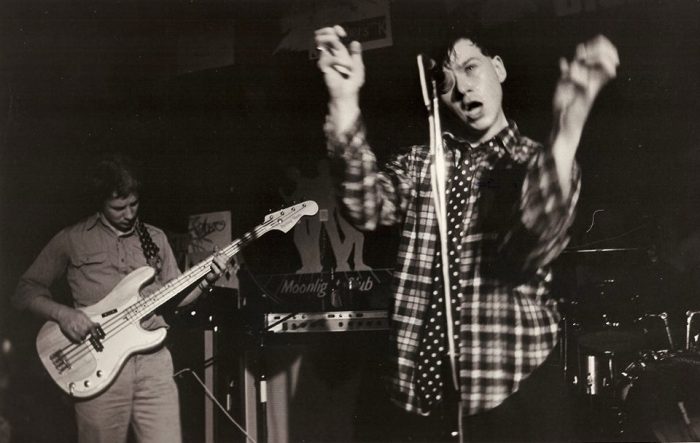 Ski Patrol in 1981. Photo by Frank Jenkinson.
Ski Patrol in 1981. Photo by Frank Jenkinson.
You were tightly involved with the Killing Joke camp, but were there any other bands you also had a relationship with or have similar photos of?
FJ: Other groups I photographed were mainly on the Malicious Damage label. So their stable was Redbeat (with the Jones brothers) and Ski Patrol with Ian Lowery (RIP) and Nick Clift… later to become the Folk Devils. Nick bought my collection of Ski Patrol photos a few years ago, and you can see some of them on the Ski Patrol Facebook page: https://www.facebook.com/Ski-Patrol-375662688134/.
FJ: Malicious Damage label produced singles for both Ski Patrol and Redbeat. I took photos of bands that shared gigs with Killing Joke, too – so I’ve photographed Joy Division, Undertones, Bauhaus, some Cabaret Voltaire, Thompson Twins (before they went commercial), Basement 5, those close to the Killing Joke crew, and Paul and Jaz pre-Killing Joke when they were with the Matt Stagger group. Other bands, I’d have to look up. These photos all stayed in boxes until Facebook gave them an audience.
What happened to Killing Joke around 1981 or so when it seems you quit being their archivist of record? Did the band change much around that time period?
FJ: As I mentioned the house was closed and the occupants (Malicious Damage) were dispersed. Killing Joke’s first USA tour took place during that summer. I moved to the outer ranges of London, got married, and a child was on the way. Had to make a living, etc. I lost contact with the band then. I continued to see the Malicious Damage people periodically.
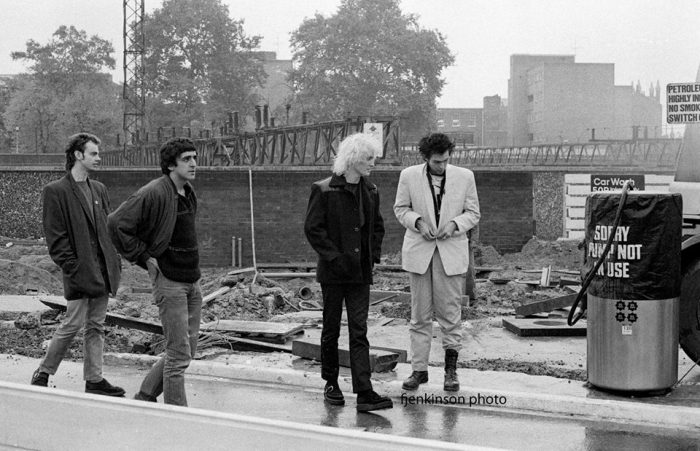
It seems like posting your photos might have opened up some old rifts that still haven’t healed; for example, Malicious Damage label head Brian Taylor’s comments about EG management on one of your posts where it seems like there were still some hard feelings. Is that what led to a fallout between Killing Joke and the 1979-1981 group of folks they were hanging around with?
FJ: Brian is in a better position to answer these questions. He has a phenomenal memory of the detail of every gig and almost every t-shirt made. I know Brian invested a huge amount of energy, cunning, and strategy, as well as most all his money. When new labels had to be approached for distribution, gigs and taxes paid for, wages, attempts to actually manage the situation did cause rifts and in the end the band, who were really quite young at that time, disposed of Malicious Damage. Mike Coles took on the label and has kept it going. Adam formed Mr. Modo Recordings in Sheffield, which was very successful for a time. Dick moved to Devon.
What do you think of Killing Joke’s later material, like with Night Time in 1985? What about their more recent stuff in the past few years (Pylon in 2015)?
FJ: I mainly play the early stuff but got back into KJ with the 2003 yellow self-titled Killing Joke LP (with Dave Grohl on drums, and all that “former Nirvana” hype) and restarted going to gigs around their 25th anniversary in Hammersmith. Frankly, I was really surprised with the fan base they still had. I had no idea. Paul and Youth had not come back to the band as yet, not until the Royal Festival Hall concert in …. 2011? There is a family aspect among the fans. Mike Coles pointed this out. But there are sets of different ones – the Gatherers, Hummers, the ones in the Church of Killing Joke, and so on.
What prompted you to finally get all your photos together into the book you made? Was it hard self-publishing it — figuring out what was printworthy, formatting it properly, making a PDF file, measurements and margins, all of that technical stuff? Was it a hard process?
FJ: Through Facebook I became aware of different KJ fan groups and I was aware that my collection might have value. Nick, Clift, Mike, and Brian would point it out. I put a few photos online and the response was great. I can’t remember exactly how the book came about originally. It seemed a good idea but I had no idea of what was involved. Sorting and matching the negatives in groups, dates, venues…. Luckily most had some markings, but none of the colour, which I had started doing. The first book I did, my son was furious – the quality was very poor. I’m colour blind and had not matched the blacks! He made me get a reasonable scanner and re-scan everything. The negatives are old, the conditions at the time were difficult, the developing was hit and miss on occasions… But age improves everything!!
FJ: There was pressure on, since I decided to do it when the 30th anniversary tour was coming up. The first three months of the band produced 100’s of photos. Self-publishing online seemed the better option, but it’s not cheap. It saved me having stock at home and posting it out myself. The difference in cost was marginal. I decided to stop at 40 pages with the thought of a second book later with the rest of the stuff. The purchase cost was rising the more pages I added, anyway, and I thought nobody would buy it if it was too expensive. I really had no idea. It took about 4 months to get it all together and a year of photos not yet sorted. My daughter came up with the idea of the Facebook page, which was a godsend.
I like to think I’ve set a trend. Mike Coles published his book of his graphic work, 40 Years in the Wilderness and Mont Sherar is coming out with a book, Twilight of the Mortals. Mine looks like a fanzine in comparison, but hey!
Has the band (Killing Joke) responded in any way to your book? What has their response been?
FJ: I’ve had some good mentions from Youth and Paul. Paul organised a meeting with me and the band at their last gig in Brixton and I gave them each a copy. Jaz remembered me as the guy with the photographs. It had been a long time and I was actually a bit overwhelmed. Despite their reluctance at the time, I’m sure they may be chuffed now; they must be one of the most visually documented postpunk bands.
Do you plan to print any other books of any other bands you’ve snapped photos of? I saw some Bauhaus and other band pics on your site…..
FJ: I have promised a second book. That whole era has an attraction, and maybe I’ll put everything into it and have them all out there. I know I should better do it before we all drop. But I’m still working at a day job, and scanning, editing, and deciding what to leave out is difficult. Finding the time is also difficult at the moment and, I’ve discovered, selling stuff is really hard work. I don’t have the personality for it it seems. Although — “Money is Not Our God”! Breaking even does encourage me. It’s also fun to put something up on Facebook from time to time, bands’ birthdays, and as the mood takes me. I reckon there will be another.
=====================================
You can order Frank Jenkinson’s Killing Joke Picture Book here.
Frank (and his daughter) have also set up a great Facebook page for the book, which contains lots of the photos above, and more, and that page is here.
And if you’re interested, I interviewed Killing Joke frontman Jaz Coleman for CVLT Nation here.


